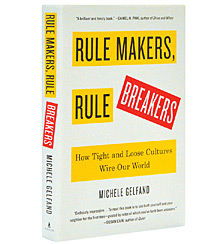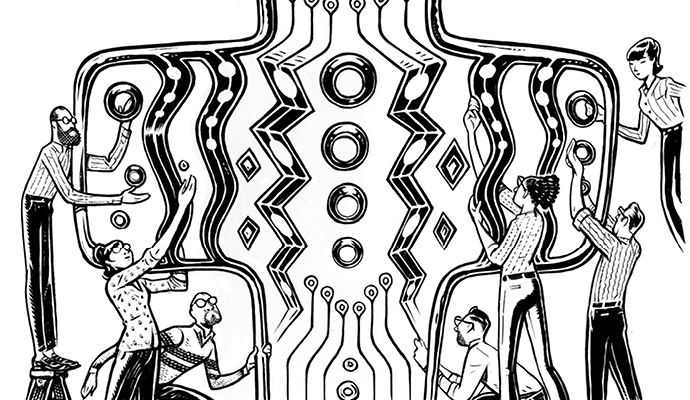Finding your company’s cultural sweet spot
In her new book, psychology professor Michele Gelfand explains some of the differences between social groups, and the conflicts that erupt among them.
A version of this article appeared in the Summer 2019 issue of strategy+business.
Rule Makers, Rule Breakers: How Tight and Loose Cultures Wire Our World
by Michele Gelfand, Scribner, 2018
“Culture eats strategy for breakfast” is a pretty tasty bon mot, though it’s doubtful that Peter Drucker, who usually gets credit for it, actually cooked it up. It can also cause severe indigestion when leaders ignore it. If you’re tempted to join them, read Rule Makers, Rule Breakers, by University of Maryland, College Park, psychology professor Michele Gelfand.
Gelfand has been studying culture and social norms for more than 20 years. Ever wonder why conjuring up a “burning platform” galvanizes workers instead of sending them scurrying for the exit doors? It’s the same reason that the heartbeats of firewalkers in the Spanish village of San Pedro Manrique, as well as the people watching them, become synchronized. It’s also why test subjects who eat fiery chili peppers together report a higher sense of bonding, and work better together in subsequent economic games. “Social norms, like participating in rituals, can increase group cohesion and cooperation,” says Gelfand.
Social norms are the glue that holds groups together. “They give us our identity, and help us coordinate in unprecedented ways,” Gelfand writes. “Yet cultures vary in the strength of their social glue, with profound consequences for our worldviews, our environments, and our brains.” And for companies, too.
Variation in the strength of social norms provides the foundation for a theory of cultural tightness–looseness that Gelfand has been instrumental in developing. The theory defines cultures with strong social norms and a lack of tolerance for deviations from them as tight cultures — the “rule makers” in the book’s title. Cultures with weak social norms and a permissive attitude toward deviations from them are loose cultures — the “rule breakers.”
To Gelfand, tightness–looseness theory explains not only the differences between social groups ranging from countries to companies, but also the conflicts that erupt among and within them. She cites the ill-fated acquisition of Chrysler by Daimler-Benz in 1988 to illustrate what can go wrong when cultures clash.
Like its home nation of Germany, Daimler, with its buttoned-down behaviors, top-down management, and emphasis on precision and consistency, leaned toward the tight side of the social-norms scale. Like the rest of the U.S., Chrysler leaned toward the loose side, says Gelfand, “with a more relaxed, freewheeling, and egalitarian business culture…[and] a leaner production style.” This set the scene for a collision of cultures that transformed a deal that had been billed as a merger into something more akin to a hostile takeover. The result: rueful jokes (“How do you pronounce DaimlerChrysler? Daimler — the Chrysler is silent”); an exodus of key executives; investor losses; and finally, in 2007, Daimler’s divestiture of Chrysler. “DaimlerChrysler failed in large part due to a colossal underestimation of the tight–loose divide,” asserts Gelfand.
“Culture is like an iceberg,” hiding perils below the surface.
Gelfand and Ivey Business School professor Chengguang Li tested that conclusion by studying more than 6,000 international mergers and acquisitions involving 30 countries between 1980 and 2013. The study yielded a valuable insight for deal makers: Deals between companies with substantial tight–loose gaps took longer to negotiate and finalize, had lower stock prices following the deal, and yielded much lower returns to acquirers. “In fact,” reports Gelfand, “when there was a pronounced cultural mismatch, the acquiring company lost [US]$30 million on average within five days of the merger’s announcement.”
Tight and loose cultures each carry their own set of costs and benefits. In tight cultures, the levels of self-regulation and coordination are higher than in loose cultures. Psychologist Robert Levine found that the clocks in the city streets of tight-culture nations are more synchronized than those in loose-culture nations! In loose cultures, there is greater openness to new ideas, diversity, and change than in tight cultures. In tolerating disorder, loose cultures create the space needed for creativity and innovation.
So, which is best? If you’re old-school enough to be setting your watch, avoid Ukraine, Estonia, and Hungary, which Gelfand numbers among the nations with the loosest cultures, and head for Pakistan, Malaysia, or India, which she finds among the nations with the tightest cultures. But when it comes to well-being, which she and her colleagues studied across more than 30 countries, the answer to which is “best” is neither. “The nations that were extremely tight and extremely loose had the lowest levels of happiness and highest levels of suicide,” she reports. “By comparison, nations that were less extreme on the tight–loose scale exhibited greater happiness scores, and lower suicide rates. The same was the case for depression.” It’s the Goldilocks principle writ large: Just right is located somewhere between too hot and too cold. Or, in this case, between too tight and too loose.
That principle also holds true for most company cultures, but the devil is in the details. How does a leader promote a culture in which conflicting tight and loose social norms — such as norms that support cohesion and diversity — exist side by side?
Gelfand’s solution is to borrow the concept of the ambidextrous organization from b-school professors Charles O’Reilly and Michael Tushman. O’Reilly and Tushman say that to survive and prosper, companies need to be able to simultaneously exploit existing assets and capabilities and explore new businesses and technologies. Gelfand says that to hit the tight–loose sweet spot, companies should become culturally ambidextrous. Loose companies should add some tight features to achieve structured looseness. For example, Google has a loose culture that encourages its workforce to pursue creative endeavors, but it also provides guidelines that govern how much time employees spend on them. Tight companies should add some loose features to achieve flexible tightness. Toyota has a tight culture that relies on rules and operating procedures, but it has decentralized decision making and described its objectives in vague terms in order to leave its managers some room for interpretation. Gelfand admits that fine-tuning a culture in this way is challenging work: “It’s not easy, no matter how minor the change.”
As they read her book, leaders are likely to think of more challenges still. For instance, how can a company maintain optimal, discrete cultures for different business units and functions (e.g., manufacturing and R&D)? And how can multinationals align the various cultures of units located throughout the world? Indeed, as Gelfand writes, “Culture is like an iceberg,” hiding perils below the surface. Rule Makers, Rule Breakers doesn’t have all the answers, but it does expose the iceberg’s dimensions.
Author profile:
- Theodore Kinni is a contributing editor of strategy+business. He also blogs at Reading, Writing re: Management.


 Photograph by Compassionate Eye Foundation
Photograph by Compassionate Eye Foundation


